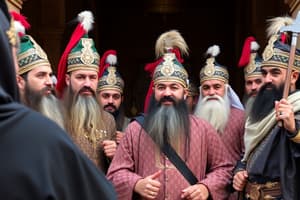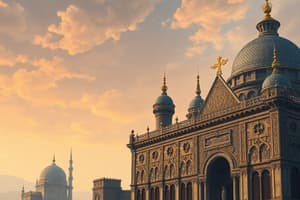Podcast
Questions and Answers
What was the role of the Janissaries in the rise of the Ottoman Empire?
What was the role of the Janissaries in the rise of the Ottoman Empire?
The Janissaries were soldiers in the elite guard of the Ottoman Turks and helped develop a strong military. They trained as foot soldiers and served the sultan or Ottoman leaders.
What aspects of Ottoman life did the sultan control?
What aspects of Ottoman life did the sultan control?
He was the political and military head of state.
How did the Ottoman Turks establish power and expand their empire?
How did the Ottoman Turks establish power and expand their empire?
Through a combination of settlement and military control, partly through an elite force known as the Janissaries.
How was the Ottoman Empire ruled under the sultan?
How was the Ottoman Empire ruled under the sultan?
What were society and culture like in the Ottoman Empire?
What were society and culture like in the Ottoman Empire?
What led to the disintegration of the Ottoman Empire?
What led to the disintegration of the Ottoman Empire?
What was the source of conflict between the Ottomans and the Ṣafavids?
What was the source of conflict between the Ottomans and the Ṣafavids?
What was the role of religion during the rule of Shah?
What was the role of religion during the rule of Shah?
What was life like under the Safavids?
What was life like under the Safavids?
How were the Moguls able to bring almost all of India under one rule?
How were the Moguls able to bring almost all of India under one rule?
What were some differences between the rules of Shāh Jahān and Aurangzeb?
What were some differences between the rules of Shāh Jahān and Aurangzeb?
What is the significance of Gurus to the Sikh religious tradition?
What is the significance of Gurus to the Sikh religious tradition?
How did the Sikh religion spread?
How did the Sikh religion spread?
What was life like in Mogul society?
What was life like in Mogul society?
What led to the decline of the Mogul Empire?
What led to the decline of the Mogul Empire?
Flashcards
Janissaries
Janissaries
The Ottoman Empire's elite soldiers, who played a crucial role in military expansion and conquest.
Sultan
Sultan
The Ottoman ruler, who held both political and military power, making him the central authority in the empire.
Settlement Strategies
Settlement Strategies
A key strategy of the Ottoman Empire that involved settling conquered territories with their own population, strengthening their control.
Ottoman Imperialism
Ottoman Imperialism
Signup and view all the flashcards
Ottoman Religious Tolerance
Ottoman Religious Tolerance
Signup and view all the flashcards
Safavid Shia Islam
Safavid Shia Islam
Signup and view all the flashcards
Mughal Military Dominance
Mughal Military Dominance
Signup and view all the flashcards
Shah Jahan's Rule
Shah Jahan's Rule
Signup and view all the flashcards
Aurangzeb's Rule
Aurangzeb's Rule
Signup and view all the flashcards
Sikhism's Foundation
Sikhism's Foundation
Signup and view all the flashcards
Women's Role in Mughal Society
Women's Role in Mughal Society
Signup and view all the flashcards
Mughal Decline and British Influence
Mughal Decline and British Influence
Signup and view all the flashcards
Ottoman Economic Decline
Ottoman Economic Decline
Signup and view all the flashcards
Ottoman-Safavid Conflict
Ottoman-Safavid Conflict
Signup and view all the flashcards
Mughal Empire's Decline
Mughal Empire's Decline
Signup and view all the flashcards
Study Notes
Ottoman Empire Overview
- Janissaries served as elite soldiers and crucial military force for the Ottoman Turks, aiding in the empire's expansion.
- The sultan held dual roles as the political and military head, centralizing control in the empire.
- Expansion relied on settlement strategies and military strength led by the Janissary corps.
Governance and Society
- The sultan's rule reflected imperialistic ambitions, characterized by succession struggles and general tolerance towards non-Muslims.
- Society was deeply influenced by Islamic customs, particularly Arabic language and Persian cultural elements inherited from the Seljuq Turks.
Causes of Decline
- Economic decline in Middle Eastern provinces was fueled by inflation due to New World resources entering Europe and trade imbalances.
- Religious conflicts arose with the Safavids, where the Sunni Ottoman Empire clashed with the Shia Safavid dynasty over spiritual leadership and military funding.
Safavid Empire Dynamics
- Shia Islam became a unifying element under the rule of Shah Ismail, who enforced conversions among Sunni populations.
- Society integrated Turkish and Persian elements, prioritizing Shia Islam, with accessible rulers and vibrant bazaar-centered trade.
Mughal Empire Expansion
- The Mughals unified most of India through numerous military conquests and effective utilization of heavy artillery against rivals.
- Shah Jahan's rule was marked by peace and religious tolerance, while Aurangzeb's reign was characterized by strict enforcement of religious policies.
Sikh Religious Tradition
- Guru Arjan set up a military tradition to safeguard the Sikh community, enhancing the significance of armed Sikhs.
- The Sikh faith was established by Guru Nanak, who emphasized distinct teachings separate from Hinduism and Islam, with nine successors that further developed the tradition.
Social Structure in Mughal Society
- Predominantly Muslim, Mughal society allowed women an active role, providing political advice, though they still faced restrictive laws.
- The arrival of the British marked the decline of the Mughal Empire, exacerbated by heavy taxation on the local population to support British interests.
Studying That Suits You
Use AI to generate personalized quizzes and flashcards to suit your learning preferences.




